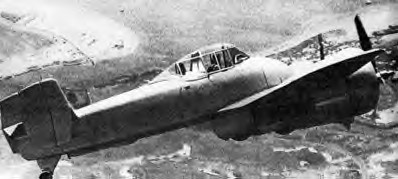In 1938, Grumman presented a proposal to the Navy for a twin engine carrier based fighter. Designated the G-34 proposal, the design was unlike any aircraft that had ever been considered before by the USN. Grumman's concept called for a light weight (under 10,000 lbs maximum take off weight) aircraft powered by two 1,200 hp Wright R-1820 engines. Being a low wing monoplane, the fuselage began aft of the wings leading edge. At the rear of the markedly short fuselage, the tail assembly was not unlike that of a B-25 Mitchell, however, with an pronounced dihedral to the horizontal stabilizer. The propellers were geared to rotate in opposite directions to cancel the effects of engine torque. The tail wheel was fully retractable. The proposed armament was two 23mm Madsen cannons.
The Navy placed an order for one prototype, designated the XF5F-1, on June 30, 1938. The prototype took to the air for the first time on April Fools day, 1940. The XF5F-1 demonstrated good flight performance, attaining a maximum speed of 383 mph at 20,000 feet. Its rate of climb easily exceeded that of its sibling, the F4F Wildcat. Despite continued modifications, Grumman failed to gain any production orders from the Navy. A different version with a longer nose and tricycle landing gear was built for the Army Air Corps under the designation XP-50, though only one prototype was built. However, the investment of time and money devoted to the XF5F-1 and the XP-50 was not wasted.
These aircraft provided a base of data which was applied to Grumman's new G-51 proposal, which was to eventually became the F7F Tigercat. Meanwhile, the XF5F-1 continued in R&D service until the end of 1944.
 Manufacturer: Grumman
Manufacturer: Grumman
Base model: F5F
Basic role: Fighter
Status: Experimental
Length: 27' 0", 8.2 m
Height: 11' 4", 3.4 m
Wingspan: 40' 0", 12.1 m
Gross Weight: 8671 lbs, 3932 kg
Powerplant: Wright XR-1820-40/42
Horsepower (each): 1200
Max Speed: 350 mph, 563 kph
Ceiling: 32000 ft, 9753 m
